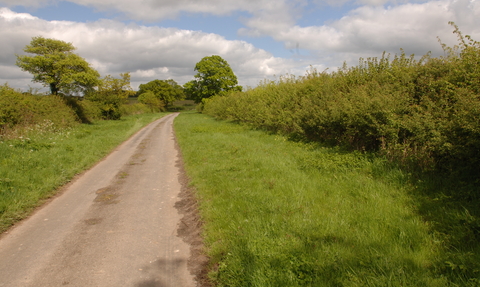
Claylands hedgerows (credit: M. Watson)
Hedgerows
Hedgerows crisscross the countryside, offering a fantastic habitat and important corridors for wildlife. Hedges mimic valuable ‘edge habitat’ and provide great diversity and connections within the landscape. Edge habitats are the transitional areas where one habitat changes into another, for example at the edge of a woodland there might be lower scrub and bushes where the woodland transitions into open habitat. These areas have a high level of diversity and are therefore favoured by many species as part of their lifecycle.
Generally, the more tree and shrub species within a hedge, the greater its value to wildlife. For example, many plant-eating insects depend on a particular plant species for food, so greater diversity supports more species. Shrub species will flower and fruit at different times, providing valuable resources for wildlife throughout the year. Hedgerow plants add even more diversity.
Having some mature trees within hedgerows is important too. Over half of the priority species associated with hedgerows are dependent, or partially dependent, on hedgerow trees.
Hedgerows are fantastic for wildlife, but that’s only part of their value.
Other benefits of hedgerows include:
-
Protecting crops and soil from the wind; every 1 metre of hedge height protects 10 metres of the land behind it from the wind
-
Shelter and shade for livestock
-
Acting as a livestock-proof barrier
-
Providing wood fuel when coppiced
-
Acting as an attractive visual barrier
-
Pest control and pollination benefits
-
Storage of pollutants and carbon
-
Flood mitigation benefits – as hedges can hold water within the landscape
For more details, see the ‘What have hedgerows ever done for us?’ page on the People’s Trust for Endangered Species website.
Despite these benefits, half of our hedgerows have been removed in the past 75 years, mainly to make room for larger scale agriculture and other development. It is vital that we now retain and manage existing hedgerows, as well as increase the number of hedgerows through new planting.
Useful links
| Find out more |
The People’s Trust for Endangered Species (PTES) have extensive information on hedgerows available on their website. Hedgelink also brings together information and resources on hedges. |
|
| Surveying hedgerows | PTES run two types of hedgerow survey: the Healthy Hedgerows survey and the more detailed Great British Hedgerow survey. | |
| Managing hedgerows | Details of the life cycle of hedges and how to manage hedgerows are available on the PTES website. | PTES - hedge management |
